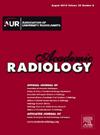基于深度学习的肿瘤和小网膜脂肪双期CT成像预测肝细胞癌微血管侵袭和生存结果:一项多中心研究。
IF 3.9
2区 医学
Q1 RADIOLOGY, NUCLEAR MEDICINE & MEDICAL IMAGING
引用次数: 0
摘要
背景:准确预测肝细胞癌(HCC)术前微血管侵犯(MVI)仍然具有挑战性。目前的成像生物标志物显示有限的预测性能。目的:建立基于肿瘤和小网膜脂肪组织(LOAT)术前多期CT图像的深度学习模型,用于预测MVI状态并分析相关的生存结果。材料和方法:本回顾性研究纳入了2016年至2023年来自两个医疗中心的病理证实的HCC患者。构建基于ResNet18的双分支特征融合模型,提取肿瘤和LOAT双相CT图像的融合特征。在内部和外部测试集上对模型的性能进行了评估。采用Logistic回归确定MVI的独立预测因子。根据MVI状态,将训练组、内测组和外测组的患者分为高危组和低危组,分析总生存差异。结果:纳入LOAT特征的模型优于仅肿瘤模型,内部测试集的AUC为0.889 (95% CI: [0.882, 0.962], P=0.004),外部测试集的AUC为0.826 (95% CI: [0.793, 0.872], P=0.006)。这两个结果都超过了三位放射科医生的独立诊断(平均AUC=0.772)。多因素logistic回归证实最大肿瘤直径和LOAT面积是MVI的独立预测因子。进一步的Cox回归分析显示,mvi阳性患者在内部测试组(风险比[HR]=2.246, 95% CI: [1.088, 4.637], P=0.029)和外部测试组(风险比[HR]= 3.797, 95% CI: [1.262, 11.422], P=0.018)的死亡风险均显著增加。结论:本研究首次使用深度学习框架整合LOAT和肿瘤影像学特征,提高了术前MVI风险分层的准确性。LOAT的独立预后价值已在多中心队列中得到验证,突出了其指导个性化手术计划的潜力。本文章由计算机程序翻译,如有差异,请以英文原文为准。
Deep Learning-Based Prediction of Microvascular Invasion and Survival Outcomes in Hepatocellular Carcinoma Using Dual-phase CT Imaging of Tumors and Lesser Omental Adipose: A Multicenter Study
Background
Accurate preoperative prediction of microvascular invasion (MVI) in hepatocellular carcinoma (HCC) remains challenging. Current imaging biomarkers show limited predictive performance.
Purpose
To develop a deep learning model based on preoperative multiphase CT images of tumors and lesser omental adipose tissue (LOAT) for predicting MVI status and to analyze associated survival outcomes.
Materials and Methods
This retrospective study included pathologically confirmed HCC patients from two medical centers between 2016 and 2023. A dual-branch feature fusion model based on ResNet18 was constructed, which extracted fused features from dual-phase CT images of both tumors and LOAT. The model's performance was evaluated on both internal and external test sets. Logistic regression was used to identify independent predictors of MVI. Based on MVI status, patients in the training, internal test, and external test cohorts were stratified into high- and low-risk groups, and overall survival differences were analyzed.
Results
The model incorporating LOAT features outperformed the tumor-only modality, achieving an AUC of 0.889 (95% CI: [0.882, 0.962], P = 0.004) in the internal test set and 0.826 (95% CI: [0.793, 0.872], P = 0.006) in the external test set. Both results surpassed the independent diagnoses of three radiologists (average AUC = 0.772). Multivariate logistic regression confirmed that maximum tumor diameter and LOAT area were independent predictors of MVI. Further Cox regression analysis showed that MVI-positive patients had significantly increased mortality risks in both the internal test set (Hazard Ratio [HR] = 2.246, 95% CI: [1.088, 4.637], P = 0.029) and external test set (HR = 3.797, 95% CI: [1.262, 11.422], P = 0.018).
Conclusion
This study is the first to use a deep learning framework integrating LOAT and tumor imaging features, improving preoperative MVI risk stratification accuracy. Independent prognostic value of LOAT has been validated in multicenter cohorts, highlighting its potential to guide personalized surgical planning.
求助全文
通过发布文献求助,成功后即可免费获取论文全文。
去求助
来源期刊

Academic Radiology
医学-核医学
CiteScore
7.60
自引率
10.40%
发文量
432
审稿时长
18 days
期刊介绍:
Academic Radiology publishes original reports of clinical and laboratory investigations in diagnostic imaging, the diagnostic use of radioactive isotopes, computed tomography, positron emission tomography, magnetic resonance imaging, ultrasound, digital subtraction angiography, image-guided interventions and related techniques. It also includes brief technical reports describing original observations, techniques, and instrumental developments; state-of-the-art reports on clinical issues, new technology and other topics of current medical importance; meta-analyses; scientific studies and opinions on radiologic education; and letters to the Editor.
 求助内容:
求助内容: 应助结果提醒方式:
应助结果提醒方式:


